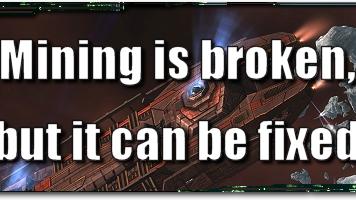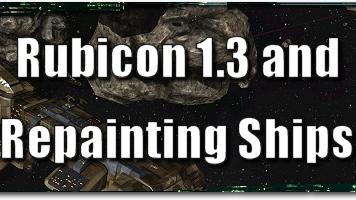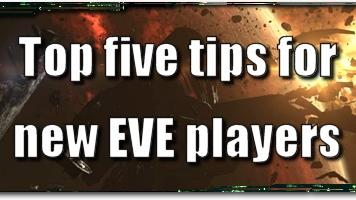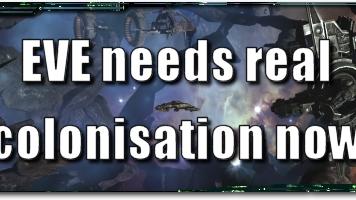eve-evolved
Latest

EVE Evolved: Eleven years of EVE Online
It seems that every year another few MMOs have closed their doors or convert to free-to-play business models to stay afloat. EVE Online has always enjoyed a level of insulation from these market trends elsewhere in the genre, and just last week on May 6th it celebrated its 11th year of year-on-year subscription growth. Following on from my previous column celebrating the EVE Evolved column's sixth year of operation, this week I'll be summarising all the major EVE news stories throughout the year. It's been a big year for EVE fans, one that many of us can be proud to have been a part of. The EVE community turned its financial wizardry toward the real world and raised over $190,000 US in relief aid following a typhoon hitting the Philippines, and CCP even built a monument dedicated to the community. Several massive player battles once again put EVE on the global media's radars, and the Odyssey and Rubicon expansions revitalised the game for explorers and PvPers alike. But not everyone can hold his heads up high this year, with details of more cyberbullying within EVE coming to light and several players being banned for defacing the EVE monument in Reykjavik. In this anniversary retrospective, I summarise all the major EVE news from the year in one place and take a look at what the future may hold for the EVE universe.

EVE Evolved: Six years of EVE Evolved
Six years ago to this exact day, I joined the Massively crew and published the first edition of this column dedicated to the ins and outs of EVE Online. The column has been home to over 300 featured articles since its creation, offering everything from guides and expansion reveals to opinion pieces, fiction, and tales of real in-game events. It's been my pleasure in the past six years to offer the Massively readers a digestible glimpse into the ordinarily somewhat impenetrable world of EVE Online and to introduce new players to the only game (other than Master of Orion II) that's managed to keep me hooked for over a decade. It's been a fantastic year to be a fan of EVE Online, with CCP announcing its long-term vision for deep space colonisation and the game being revitalised through the Odyssey and Rubicon expansions. I've had the opportunity to explore both expansions in this column and to share some hands-on experience with DUST 514 and CCP's upcoming dogfighter EVE Valkyrie. There's been no shortage of opinion pieces this year either, with articles on everything from PvP consequences and twitch controls to whether Star Citizen and Elite are a threat to the sandbox giant. In this edition of EVE Evolved, I round up the best articles from the column's sixth year of operation in one place.

EVE Evolved: Anatomy of a mining op
When EVE Online was first released in 2003, it was designed as a massive universe of competition and conflict between space-faring megacorporations in the distant future. Players bought into the premise completely and soon set about building their own empires and waging wars with neighbours. Corporations ran regular mining operations for resources to build frigates and cruisers for their members, and some of the larger corps co-operatively mined to build the first ever battleships in the game. The mining op has been a staple activity in the game ever since, providing a way for groups to work together on large manufacturing projects or just make some ISK during their down-time. Mining gets a lot of flak for being one of the most boring and least profitable professions in the game, but that's not exactly true. Solo mining can be a great way to spend your downtime while doing other activities, and it ensures that you're online when something exciting happens like a live event, your wormhole system being invaded, or a titan being tackled by your alliance. Co-operative mining ops also offer the social value of bonding with your corpmates when there's nothing else going on. Some players even run dozens of accounts at the same time to turn this ordinarily placid activity into an intensive profit-making activity focused on efficiency and organisation skills. With mining due to make a resurgence in the summer expansion, this edition of EVE Evolved is dedicated to the humble mining operation. I'll take a look at the various options for mining ships, the different haulers available, and the four different areas you can mine in.

EVE Evolved: Mining is broken, but it can be fixed
Mining has a reputation for being the most boring activity in EVE Online, but it's always filled a niche role as a low-effort way to make ISK and play with friends casually. When there's no PvP going on and you can't give your full attention to smashing NPCs in missions or anomalies, mining fills that downtime with something more lucrative and social than spinning your ship in a station. The problem is that mining has slowly become obsolete over the years; alternative mineral sources now supply much of the market's needs, and the risk of flying a defenseless barge just isn't worth the mediocre payout. It's currently more efficient for an individual to buy minerals with ISK made via some other form of PvE, such as level 4 missions or incursions. And on the macroscopic level, such huge quantities of minerals hit the market from alternative sources such as reprocessing loot that the economy could potentially function with no miners at all. CCP has tried to make mining more appealing over the years with buffs and new ships, and the devs recently announced plans to nerf mineral compression as part of a campaign to make mining worthwhile, but I think it'll take a lot more than ISK to get people mining again. In this week's EVE Evolved, I look at how mining and reprocessing are at odds and suggest some ideas for new mining features that could revitalise this long forgotten profession.

EVE Evolved: Rubicon 1.3 and repainting ships
EVE Online's recently released Rubicon expansion was an important first step toward a truly player-run universe for everyone, allowing corporations to wage empire wars over planetary customs offices and introducing a series of new personal deployable structures. The initial release was a little light on content, but developers have since expanded on it significantly with three major point releases. Rubicon 1.3 went live this week, and the changes seem pretty good all around. This release overhauled the directional scanner, buffed the SoE Nestor battleship's capacitor recharge rate and remote repair range, and nerfed remote sensor dampeners into the ground. Large corporations like EVE University were pleased to hear that the limit on the size of corporations has been increased to 12,600 thanks to changes to the corporation management skills. And in response to an emerging trend in fleet warfare involving hordes of drone ships assigning their drones to an interceptor, developers have also limited the number of drones that can be assigned to another ship to 50. The 1.29 GB patch also included several overhauled ship models and new ship shaders, but the new feature I see the most potential in is the ability to finally repaint our ships. This could eventually help corporations establish their own visual identities and might even link into gameplay or EVE's spying metagame. In this edition of EVE Evolved, I look at some of the Rubicon 1.3 changes and how repainting your ship could become more than simply a cosmetic upgrade.

EVE Evolved: What to expect from EVE Fanfest 2014
Almost 10 years ago, EVE Online developer CCP Games started a new tradition with the first ever annual EVE Fanfest. The event started out as a largely informal gathering in a tiny venue that allowed players and developers to mingle on a more personal level, but it's now grown into something massive. Over a thousand players now make the annual pilgrimage to EVE Online's birthplace in Reykjavik, Iceland, to hear what the future holds for their favourite MMO. For many, the event is also a social gathering, a chance to swap stories with other players, and a rare opportunity to meet the corpmates they fly with every day in the virtual galaxy of New Eden. The Fanfest weekend is typically a packed schedule of panels, talks, roundtable discussions with developers, and keynote speeches revealing the future of the game. While the event is understandably focused on EVE Online, it's recently expanded to cover aspects of DUST 514, the latest goings-on with World of Darkness, and even CCP's new virtual reality dogfighter EVE Valkyrie. CCP has announced that this year's event will see a monument to the EVE playerbase unveiled in Reykjavik Harbor as well as the first reveal of EVE's summer expansion, but what else can we hope to glean from this year's event at the start of May? In this edition of EVE Evolved, I delve into the EVE Fanfest announcement and speculate on what we might expect to hear from this year's event. Will this be the year that World of Darkness gets some serious news? And what's new for DUST 514?

EVE Evolved: Top five tips for new EVE players
I often hear people say that EVE Online is a lot more fun to read about than actually play, and I've even caught myself saying it jokingly to friends and writing it in articles. But the truth is that amazing stories like the recent world record-breaking Bloodbath of B-R5RB are a hell of a lot better when you're a part of the action or have the first-hand experience to put the event into a wider context. All of EVE was impacted by that battle, with its effects rippling through the in-game markets and reshaping the political landscape of New Eden. But to read about it, you'd think the carnage in B-R5RB ended when $310,000 US worth of titans went up in smoke. EVE has seen a huge influx of fresh faces since that colossal battle at the end of January, with thousands of new characters being created and the Rookie Help channel bursting at the seams. Whether you've always been a closet fan of EVE who has finally been convinced to take the plunge or you just want to join the ranks of the warring alliances you've read so much about, starting out can be a daunting experience. The sheer amount of information there is out there to absorb and sort through is overwhelming, and not all of it is up to date. CCP released a great new player guide recently to help newcomers assimilate, but I've still received several emails asking for advice on getting started. In this week's EVE Evolved, I delve into the new-player experience with a 14-day free trial and reveal my top tips for starting out on the road to creating your own sandbox story.

EVE Evolved: Consequences and conflict
I've always considered EVE Online to be the model sandbox MMO and a template that could theoretically be applied to other titles. Whether you believe it's by careful design or a happy accident, EVE has stumbled on a formula that clearly works and has helped the game stay popular for over a decade. I've written before about the many interconnected parts that make EVE's sandbox model work and how pulling out essential features such as item loss on death or adding foreign mechanics like global banking could cause the whole game to fall apart. But there's one aspect I didn't really cover in depth: consequences for negative behaviour. In his latest Some Assembly Required column, Massively's Jef Reahard argued that EVE can't be considered the quintessential sandbox MMO because it lacks consequences for bad behaviour. While I would argue that EVE is as close to the ideal model of the genre as exists at the moment, I'm forced to agree with Jef's assessment. Almost all of the major events in EVE's recent history that have hit the gaming media have been about theft or war, with tales of massive scams and alliance warfare painting New Eden in a dark and violent light. The ultimate sandbox would be equally capable of birthing incredible stories of exploration and players working together to build magnificent things, not just chaos and death in the gloomy depths of interstellar space. In this week's EVE Evolved, I look at the lack of consequence for negative actions in EVE Online, whether it causes negative behaviour, and why sandboxes need to be about more than just destruction.

EVE Evolved: The top five most dangerous solar systems
EVE Online is a PvP game at its core, with conflict built in at a fundamental level. Pirates lurk around key trade routes and stand ready to pounce on unsuspecting victims, while vast nullsec alliances protect their territories with watchful vigilance and never-ending bloodlust. Wander into the wrong solar system as a new player and your precious ship and cargo will be turned into molten slag and a few points on a killboard quicker than you can say, "Hello, new friend, and what does that red square on your ship mean?" The original map of EVE was generated one evening by an Icelandic developer who could scarcely have known he was deciding the fates of thousands of gamers for years to come. New systems have been added to the game over the years, and a few manual changes have been made to the stargate network, but most of the universe has remained the same for over a decade. In all that time, a few solar systems have stood out as brazen bastions of bastardly behaviour and made their marks on EVE's history. In this week's EVE Evolved, I run down a list of the top five most dangerous solar systems in EVE's long history and delve into why each has earned its reputation as a no-fly-zone for newbies.

EVE Evolved: The Bloodbath of B-R5RB
To the vast majority of gamers, EVE Online is an unforgiving sci-fi dystopia that's one part epic sandbox stories and nine parts spreadsheet. Once or twice per year, the gaming masses get a glimpse of the game's true depth when stories of incredible wars, political corruption, and record-breaking heists spread across the internet like wildfire. From the 2005 Guiding Hand Social Club heist that was plastered over the pages of gaming magazines to last year's infamous Battle of Asakai, tales of big events from EVE have always managed to grab the gaming media's attention. This week saw the largest record-breaking battle to date as a total of 7,548 players belonging to EVE's two largest megacoalitions fought for control of an innocuous dead-end solar system in the Immensea region. A total of 11 trillion ISK in damage worth over $310,000 USD was inflicted during what has now become known as The Bloodbath of B-R5RB and is allegedly the largest PvP battle in gaming history. The odd story of how the fight started and its record-breaking destructive scale are both big news, but the unsung heroes of B-R5RB are the people who work behind the scenes to ensure that the server can remain online during major battles. In this week's EVE Evolved, I look at how one player forgetting to check a box on a form sparked this immense battle and how technologies like Time Dilation help to keep the server online when the ship hits the fan.

EVE Evolved: EVE needs real colonisation now
MMOs have absolutely exploded in popularity over the past decade, with online gaming growing from a niche hobby to a global market worth billions of dollars each year. Once dominated by subscription games like EverQuest and World of Warcraft, recent years have seen free-to-play games take centre stage. Global MMO subscriptions have been reportedly shrinking since 2010, and EVE doesn't appear to be immune to this industry-wide trend. Though February 2013's figures showed EVE subscriptions have technically grown year-on-year, those numbers were published just after the Chinese server relaunch, and CCP hasn't released any new figures since. Developers have done a good job of catering to current subscribers and polishing existing gameplay with the past few expansions, but the average daily login numbers are still the same as they were over four years ago. EVE will undoubtedly hook in plenty of new and returning subscribers when its deep space colonisation gameplay with player-built stargates and new hidden solar systems is implemented, but time could be running out on these features. Hefty competition is due in the next few years from upcoming sandbox games such as Star Citizen, EverQuest Next, Camelot Unchained, and Elite: Dangerous, and CCP will have to release something big soon to bring in some fresh blood. In this week's EVE Evolved, I ask whether CCP should focus on new players and suggest plans for two relatively simple colonisation-based expansions that could get EVE a significant part of the way toward its five-year goal in just one year.

EVE Evolved: Has colonisation been forgotten?
At last year's EVE Online Fanfest, CCP revealed its ambitious plan to take the game where no sandbox MMO has ever gone before: full deep space colonisation. The plan will be delivered over the next five years and will end with the incredibly exciting vision of players building their own stargates and colonising brand-new solar systems that lie off the grid. Rubicon was intended as the first step toward this glorious plan, and its new focus on deployable sandbox structures certainly seemed to be introducing a more player-directed form of colonisation. I've been cautiously optimistic about the whole endeavour so far, but five years is hell of a long time to wait for that vision to come to fruition. Rubicon's Mobile Depot structure was a great first step toward player-run empires on all scales, but none of the recently announced Rubicon 1.1 deployables has continued along the same theme of colonisation and exploration. The Mobile Micro Jump Drive and Mobile Scan Inhibitor structures I looked at last week provide extra tactical options in PvP, and the three new structures revealed this week are all designed to steal money and resources from nullsec corporations. In this week's EVE Evolved, I ask whether the newly revealed Encounter Surveillance System and alternate Siphon Units are a step in the wrong direction. With games like Star Citizen and Elite: Dangerous on the way, CCP may not have five years to deliver the promise of colonisation.

EVE Evolved: Rubicon 1.1's new deployables
Of all the major changes to EVE Online in the past few years, it's the introduction of personal deployable structures that has had me most excited. I've always been of the opinion that a true sandbox should let individual players and larger organisations build their own personal empires in empty wilderness. If it were up to me, everything from mining and manufacturing to research in EVE would take place in destructible structures and possibly even player-built deadspace dungeons. The Rubicon expansion took an important first step toward this brand of sandbox-style gameplay with the introduction of several new personal deployable structures, including an item hangar and refitting service that can be deployed anywhere in space. Four more structures were initially planned for the Rubicon 1.1 point release to expand the game's tactical possibilities, and this week two of those structures were confirmed. The Mobile micro Jump Unit is a game-changing strategic device that allows players any nearby players to jump their ships 100km forward, and the highly requested Mobile Scan Inhibitor physically hides nearby ships from probes and the directional scanner. Players on the test server have also discovered overview filter options for Mobile Jump Disruptor and Mobile Decoy Unit deployable structures, but developers were unable to confirm whether these would be part of Rubicon 1.1 or even if they'd definitely make it into the game. In this week's EVE Evolved, I look into the tactical possibilities of the Mobile Micro Jump Unit and Mobile Scan Inhibitor and why some players have reservations about these game-changing strategic structures.

EVE Evolved: Designing EVE Onland, part 2
When it comes to living sandbox MMOs, there really isn't a bigger name than EVE Online. Throughout its decade-long history, EVE has produced some huge gaming headlines, delivered record-breaking in-game thefts and heists, and played host to the complex political machinations of dozens of warring alliances. EVE's sandbox design has even made it remarkably resistant to changes in the market, with subscription numbers remaining relatively stable in the face of new releases and the free to play phenomenon. It comes as no surprise then that the sandbox genre is seeing a triple-A revival, with games like Star Citizen, EverQuest Next Landmark, and Camelot Unchained on the way. With the sandbox genre due to explode back onto the fantasy scene, I've been left wondering how much of the core gameplay that makes EVE tick could be easily adapted for an avatar-based game on land. Even features such as EVE Online's trademark territorial warfare and player-run economy have roots in classic fantasy MMOs like Ultima Online, so they should be easy to convert to modern fantasy equivalents. Last week I started this game design thought experiment with a territorial warfare system and free-for-all PvP with harsh consequences for attackers, but there's a lot more to a good sandbox than smashing people's heads in. In this week's EVE Evolved, I delve into the hypothetical world of EVE Onland again and tackle issues of realistic world scale, exploration, economics, and the evils of global banking.

EVE Evolved: Designing EVE Onland, part 1
When I'm not playing or writing about EVE Online, I can usually be found huddled over my computer typing lines of code into a compiler and chipping away at bugs that make varying degrees of sense. Designing my own hardcore space game is a really fun challenge and very fulfilling work, but I have a dirty little game dev secret: I've actually always wanted to make a fantasy game. While the budget and personnel required to take on a project the scale of an MMO remain quite far outside my grasp for the moment, it's still fun to think about how I might design such a game if the opportunity arose. The MMO genre seems to be heading for a sandbox revolution this year, and there's no bigger sandbox than EVE Online, but could all of EVE's gameplay translate to a fantasy game? EVE is probably the most atypical MMO out there, maintaining a subscription-based single-shard PvP sandbox in a genre that's typically headed in the exact opposite direction. There are several new sci-fi sandboxes on the way that may or may not qualify as massively multiplayer titles, but the vast majority of MMO gamers still prefer to keep their feet on the ground in fantasy lands. I often find myself wondering how much of EVE Online's core gameplay is possible only because of its setting -- and how much could actually be applied to a fantasy MMO. Not only should it be possible to adapt most of what makes EVE great to a modern land-based game, but many of the mechanics sandbox gamers now attribute almost solely to EVE actually started life in classic fantasy MMOs like Ultima Online. In this week's unusual EVE Evolved, I'd like to start a game design thought experiment as I delve into the hypothetical world of EVE Onland.

EVE Evolved: Unleash your inner space janitor
Did you know that people leave perfectly good stuff just lying around in space?

EVE Evolved: Three exploitable game features
If there's one thing EVE Online players are good at, it's finding ways to get an advantage over each other. The hyper-competitive PvP sandbox breeds players with an investigative streak who will constantly figure out ways to bend and abuse new features to make ISK or get an edge over other players in combat. The most obvious cases include abusing bugs, as happened in 2009's starbase exploit that corporations used to generate valuable tech 2 materials out of thin air and 2010's MonkeySphere exploit that let players hide themselves from the local chat channel and sneak up on unsuspecting victims. Most cases of abusing features for profit or advantage aren't as clear-cut as these obvious exploits, as some have negative consequences but still use completely legitimate game mechanics. When players figured out how to abuse Faction Warfare's kill LP rewards to farm five trillion ISK, for example, they did so using in-game mechanics that just hadn't really been thought through. Many more subtle cases of broken game mechanics that undermine EVE's core design ethos still exist, some of which have been recently introduced and others that have managed to remain unchallenged for years because there isn't really a good alternative. In this week's EVE Evolved, I look at three features in EVE Online that I think fundamentally break the design ethos of the game but don't have very clear solutions.

EVE Evolved: Lowsec isn't impenetrable
When EVE Online was created, one of its core design philosophies was the idea of risk vs. reward -- that higher-value activities should expose the player to greater risk of loss. This rule naturally follows from how the world of business and competition works in real life, and I think it will always arise organically from sandbox MMOs with limited resources. If something's risk-free and easy to do, you can bet there are countless other people already doing it and squeezing the profit margins. This idea was also built into EVE at a fundamental level, with the galaxy split into police-protected high-security systems, the pirate-infested low-security borders between nations, and the chaotic uncolonised wilderness of nullsec. The steep step up in risk when transitioning from high- to low-security space has always been a major point of contention with gamers, as those who don't know any better often charge straight into deep space to their deaths. The story of the newbie working his way up to get his first cruiser or battlecruiser and then losing it to pirates is repeated so often on forums and in the comments sections of articles that it's almost become a cliche. While the idea that pirates wait around every corner lingers on, this impenetrable barrier hiding all the best content from new players no longer really exists. Through the addition of wormholes and the changes made in Rubicon, no star system is now off limits to a pilot with just a few months of skill training under his belt. In this week's EVE Evolved, I look at what you can do to safely travel and operate in EVE's dangerous areas, why the barrier into low-security space needs to remain low for new players, and how CCP has expanded the EVE universe through the introduction of riskier areas of space.

EVE Evolved: Donate your old spaceships to charity
The Philippines recently suffered its worst natural disaster in living memory when typhoon Haiyan made landfall on November 8th, leaving over half a million people displaced and millions without food and basic supplies. Countries and organisations around the world have been sending relief aid into the region, and gamers have once again proven to be a generous bunch. Several livestreamers have been running donation drives; the developers behind Luvinia Online even promised to donate 100% of the income from three new in-game items to the Philippine Red Cross. EVE Online has now also joined in the fundraising by reactivating its popular PLEX for Good scheme. CCP started the PLEX for Good scheme back in January of 2010 as a way for players to donate in-game assets and ISK to help people in the real world. EVE Online players have collectively donated over $150,000 US in aid following 2010's Haitian earthquake, tsunami devastation in Japan, flooding in Pakistan, and tornadoes in the US two years ago. Players hope to smash all fundraising records this time around with dedicated fundraising auctions, events, and liquidation firesales happening across the game. There are even ways for ex-players without active subscriptions to donate their idle in-game assets to charity. In this week's EVE Evolved, I look at the PLEX for Good scheme, the fundraising efforts players are using to help out a country in need, and how you can donate your ISK to charity even if you've long since quit EVE.

EVE Evolved: First impressions of Rubicon
For years I've been writing that EVE Online needs more deployable sandbox structures that any player can use, so I was naturally pretty excited to hear that this was to be one of the key features of the Rubicon expansion. The Mobile Depot sounded like a great freeform sandbox tool when it was announced, but I didn't understand quite how awesome it was until I started setting up my own. While the depot is ostensibly a fancy item container with a ship fitting service, anchoring one feels almost like planting your flag in space, and spotting another depot on the directional scanner means war. I've spent this week exploring low-security space in the new Stratios Sisters of EVE faction cruiser, stealing rare moon minerals with a Siphon Unit, and desperately searching for the elusive but valuable ghost sites. As expected, players have already found some creative uses for the new personal deployable structures: Mobile Depots are being used as advertising billboards in Jita and to bait aggressive players into becoming flagged as criminal suspects, Mobile Tractor Units have seen some unorthodox usage outside of missions, and the Siphon Unit will literally print money if you find an unsecured moon-mining operation tucked away in space. In this week's EVE Evolved, I test-drive the Rubicon expansion's new structures to find out if they live up to expectations.
